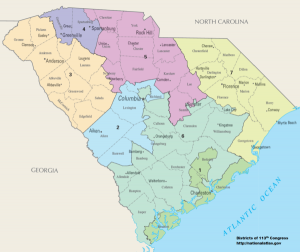By Andy Brack, editor and publisher | Perhaps it was naivete, youth or idealism. Maybe all three. But I never felt trapped by gerrymandering during a run for Congress in 2000. I believed people from Seabrook Island to Little River in the First Congressional District were ready for someone different.
 Today, of course, I know different. I could have been George Washington himself and not won a seat in Congress that year because of the way the district lines favored Republicans thanks to gerrymandering. After two years of work and more than $500,000 raised, I got 36 percent of the vote – the percentage a Democrat typically got in that seat.
Today, of course, I know different. I could have been George Washington himself and not won a seat in Congress that year because of the way the district lines favored Republicans thanks to gerrymandering. After two years of work and more than $500,000 raised, I got 36 percent of the vote – the percentage a Democrat typically got in that seat.
When you peel back the numbers on that race, you discover about 30 percent of people who lived in the general district were black. But because of the way district lines were carved, the black voting percentage was much lower – about 18 percent. That meant the cartographers at the Statehouse who drew the district lines excised African American voters, who strongly tend to be Democratic, from the First District. Essentially, they cut out blacks and made the First District “whiter” than it was in real life. The result: a district where any Democrat started out behind and without the voting base expected in a fairly-drawn district.
If, for example, the district included a black voting population of 30 percent instead of 18, there’s a strong likelihood that my voting total would have been 48 percent, rather than 36 percent. In other words, the race would have been viewed by funders in Washington as competitive – and they might have dumped in cash as they promised to help turn the district blue.
For the record, I’m not whining about any of this. It would have been fun and engaging to have gone to Washington – back then. You couldn’t drag me there now.
The reason I relate the story is to highlight how redrawing district lines, which happens every 10 years after the U.S. Census, really makes a difference. If you want to see how drawing lines in different ways can have different outcomes, see a new series called “The Atlas of Redistricting” by the analysts at FiveThirtyEight.com. It shows eight congressional maps for each state:
“Each map has a different goal: One is designed to encourage competitive elections, for example, and another to maximize the number of majority-minority districts. See how changes to district boundaries could radically alter the partisan and racial makeup of the U.S. House – without a single voter moving or switching parties.”
The first map – the state’s current congressional boundaries – coincides with the second map, which gerrymanders the state to favor Republicans. It offers six Republican districts and one Democratic district.
The third map, which redraws the map to favor Democrats, likely would create three Democratic districts and four Republican ones. A fourth map, which would match the partisan breakdown of seats to the electorate, would create one Democratic district, two competitive districts leaning to Democrats and four Republican seats. A fifth map to promote highly competitive elections would look the same.
A sixth map to maximize the number of majority-minority districts would yield two likely Democratic districts and five Republican. A seventh – and odd – map to make districts compact using a computer algorithm would create two strong GOP districts, three mostly Republican districts, one leaning GOP and one Democratic. Finally, a gerrymandered map to make the districts compact but follow county borders would create four usually GOP seats and three highly competitive seats, one of which favored Democrats.
The point of all of this is that lines matter. And now with sophisticated computer programs and simulations available like never before, maybe yesterday’s blatant gerrymandering will become a thing of the past. If so, then redistricting that’s coming in 2021 could do what the Founding Fathers intended – to redistribute representational power in a fair way based on population shifts.
And that would be a major change. But to make it happen, citizens and advocacy groups must dig down and get involved in the process by offering reasonable alternatives. And if politicians draw lines to protect their hides, groups ought to take the official line-drawers to court to hold them accountable.
Democracy works best when people are fairly represented. What we’ve got now at the Statehouse and in Congress isn’t working.
- Have a comment? Send to: editor@charlestoncurrents.com





 We Can Do Better, South Carolina!
We Can Do Better, South Carolina!
























